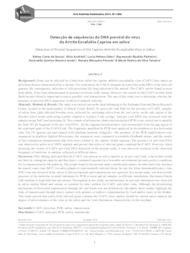Detecção de sequências do DNA proviral do vírus da Artrite Encefalite Caprina em saliva.
Detecção de sequências do DNA proviral do vírus da Artrite Encefalite Caprina em saliva.
Author(s): SOUZA, K. C. de; ANDRIOLI, A.; SIDER, L. H.; PINHEIRO, R. R.; BEZERRA JUNIOR, R. Q.; PEIXOTO, R. M.; TEIXEIRA, M. F. da S.
Summary: [Detection of Proviral Sequences of the Caprine Arthritis Encephalitis Virus in Saliva]. Background: Goats can be infected by a lentivirus called the caprine arthritis encephalitis virus (CAEV) that causes an infectious disease characterized by a chronic. For replication, the CAEV, integrate as a provirus in the DNA of the host cell genome. By consequence, infection of cells persistent life-long infection of the animal. The CAEV can be found in most body fluids, It has been demonstrated its presence in blood, milk, semen. However, the search for the CAEV in other body fluids besides blood is important to assess possible viral transmission. The aim of this study was to determine whether the presence of proviral DNA sequences in saliva of animals infected. Materials, Methods & Results: The study was carried out on the farm belonging to the Embrapa Goat and Sheep Research Center, located in the municipality of Sobral, Ceará, Brazil. To assess the oral fluid for the presence of CAEV, samples of saliva from eight infected breeders were collected by suctioning saliva from the oral cavity on the side region of the breeders lower molar teeth using a probe coupled to a plastic 5 mL syringe. And pro-viral DNA was extracted from the samples using NaCl and proteinase K. Two rounds of polymerase chain reaction (nested PCR) were carried out to amplify the final 187 pb fragment of the pro-viral DNA. All the oligonucleotide primers were determined from the gag region of the structural gene of the CAEV-Cork. The fragments amplified by PCR were analyzed in electrophoresis in a horizontal cube. On 2% agarose gel and stained with ethidium bromide (10?g/?L). The products of the PCR ampli?cation were sequenced in platform Applied Biosystems, the sequences were compared to available GenBank strains, and the results of this comparison demonstrated that were more related to the caprine strains regional. The presence of pro-viral DNA was observed in saliva in of 100% animals and proved that saliva of infected goats contained the CAEV. However, when assessing the results of CAEV pro-viral DNA detection in the present study, it was observed variation in the detection frequency of lentivirus in samples collected at different times. Discussion: This finding indicated that the CAEV was present in saliva samples in its pro-viral form, a factor that would not limit its contagion capacity and that direct, continued exposure in a favorable environment presents perfect conditions for its transmission by this pathway. The results found in the present study corroborated studies on other lentivirus. Isolated the maedi-visna virus (MVV) in saliva glands of experimentally infected sheep. In cats, the feline immunodeficiency virus (FIV) was also detected in the saliva of infected animals and transmission was reported. In a recent study, was detected the presence of the lentivirus in small ruminants by PCR in water and air samples in different installations that housed herds with medium to high infection prevalence. Throughout in this study, an intermitency in proviral elimination was observed in saliva similar blood and semen, as reported by other authors for CAEV and other virus. Although the determining mechanism of horizontal transmission through the oral fluids was not definitively elucidated, these studies highlight the risks of transmission through direct contact with animals or indirect contamination by food and/or water in the drinker. This study proved that saliva from infected goats contains the CAEV, more studies should be carried out to analyze the degree of infectiousness of the virus in the saliva and the viral elimination characteristics in this medium.
Publication year: 2015
Types of publication: Journal article
Unit: Embrapa Goats & Sheep
Observation
Some of Embrapa's publications are published as ePub files. To read them, use or download one of the following free software options to your computer or mobile device. Android: Google Play Books; IOS: iBooks; Windows and Linux: Calibre.
Access other publications
Access the Agricultural Research Database (BDPA) to consult Embrapa's full library collection and records.
Visit Embrapa Bookstore to purchase books and other publications sold by Embrapa.

